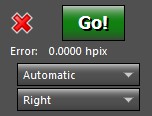< Previous | Contents | Manuals Home | Boris FX | Next >
Fisheye: in Equidistant, Equisolid, Orthographic, and Stereographic versions. These handle the four basic fisheye lens types, including 2 nd, 4th, 6th , and 8th-order distortion. Typically, start with Equisolid, with enough distortion terms enabled it’s not clear there’s much difference between the types in practice. Fisheye shots require special treatment of field of view (always Known, at the maximum value desired) and focal length (decoupled from the field of view, in order to try to match the lens’s rated focal distance). These are all in the compositing-friendly direction; the Std. isn’t called out explicitly.
Parameter Animation Solving Modes
If your shot has a zoom in it, either due to a focus change or an operator changing the zoom setting on a zoom lens, not only will the camera field of view change, but the lens distortion settings may change as well, especially for significant zooms or focus changes on anamorphic lenses.
Tip: See the Focus Breathing and Zoom tutorials in the Lens Distortion tutorial section and the SynthEyes 2304 Youtube playlist .
SynthEyes supports animated lens distortion parameters, but they must be used carefully and wisely. First, let’s consider the options available, then what to do with them. Here’s a typical control panel; this for the Standard Radial 4 th-order lens model (compositing-friendly).

This hypothetical example shows the different solving modes, in order of increasing numbers of solved parameters, but not necessarily usefulness:
Manual. The parameter isn’t calculated at all; the existing parameter values are used without change. This might be a single value (preferably a key at the beginning of the shot), or a whole keyed parameter curve.
Calculate. A single value is computed that works best for the entire duration of the shot.
Animate at keys. A value is computed for each manually-placed existing keyframe of the parameter. Other values are linearly interpolated from the key values; the keyed values are optimized to produce the best result for all frames affected by the key’s value, not only the key frame itself.
Animate by frame. A value is computed for every frame . This mode should never be used in the final version of a tracked scene. Read on for when and how to use it.
©2024 Boris FX, Inc. — UNOFFICIAL — Converted from original PDF.
